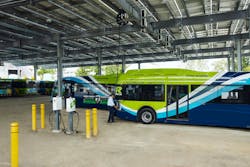The passage of the Inflation Reduction Act of 2022 not only marks the largest investment ever passed by Congress to combat climate change, but also serves as a critical signpost in our decarbonization history. Through this bill $370 billion will be dedicated to energy transition and accelerating our nation’s climate goals, and we can’t afford to wait any longer to put it into action.
Opportunity for microgrids
The bill reinstates and expands numerous clean energy incentives by implementing new energy tax credits over the next 10 years, creating a favorable window of opportunity to make the switch to clean energy. This extension will make it less expensive to invest in sustainable technology, advancing renewable energy deployments like distributed energy resources (DERs).
Further, the removal of the manufacturing cap will favor increased production for clean energy technology like electrical vehicles (EVs) and digitized buildings, making sustainable technology more accessible. However, with the aging grid infrastructure, more resilient power infrastructure will be essential to maximize this technology. Microgrids allow a decentralized power infrastructure for more sustainable power and greater power resilience.
Finally, the bill shifts to emissions-based credits to better track progress on sustainability goals. For example, it creates a zero-emission production tax credit (PTC) for electricity produced in a qualified nuclear power facility. This can help keep utilities with nuclear assets up and running when power prices are low – providing greater stability. This also creates an opportunity to innovate for plant life extension, with more investments outside of nuclear and more enhancements to monitor emissions. Enabling these plants to potentially remain open longer may improve reliability in some regions, which could, in turn, reduce power price volatility.
Increased investment in resilient infrastructure
In order to capitalize on the opportunity that this bill presents for clean energy technology, there will need to be significant improvements to our aging infrastructure. Take Montgomery County, Maryland, as an early example. Last fall, the county broke ground on a microgrid that will not only power its Smart Energy Bus Depot, but also reduce all carbon emissions by 2035. With the IRA bill early adopters, like Montgomery County, we can continue to make forward progress on climate goals.
Communities that are just starting on their decarbonization journey are strongly positioned to invest in and adopt clean energy. The tax credit expansion along with energy-as-a-service (EaaS) models make DERs even more accessible and manageable. For example, AlphaStruxure, a joint venture between Schneider Electric and the Carlyle Group, offers an EaaS model that doesn’t require upfront capital investments. It can also operate microgrids via a cloud-connected network operations center providing 24/7/365 operations, monitoring and optimization of energy performance, further alleviating the burden from communities that don’t have the resources to manage the project on-site.
While microgrids can – and already are – powering EV fleets for more resilient and efficient usage, leveraging digital models to develop and model performance will provide proof of concept and demonstrate value even before the “switch” is turned on.
Computer-aided design modeling tools like digital twins can create a simulation that enables analysis of various designs long before decisions are made. Though the tax credits help lower investment costs, DERs still come with a cost. Amid an uncertain economy where budgets are reevaluated regularly, this digital approach gives organizations and communities reassurance in their investments and can help depict the long-term cost savings.
Support for the grid
Deploying EVs and electrification on a massive scale cannot be done without considering the impacts on the grid. Integrating DERs and using intelligent controllers to monitor and manage loads in real time prevent increased stress on the grid, providing sustainable and resilient power supply. Any community that is considering electrifying fleets with the new IRA funding should also be considering ways to ensure grid stability and security.
Both the Infrastructure Investment and Jobs Act and the IRA bring an opportunity for progressive collaboration with the utilities behind the meter. Last year alone, the United States faced 22 extreme weather and climate-related disaster events with losses exceeding $1 billion each – a cumulative price tag of nearly $100 billion. Dedicated investment in diverse power sources brings a resilient infrastructure to help the nation adapt to the inevitable impacts of climate change and respond to extreme weather events.
Moving away from the ‘experimental phase’
The IRA bill signals clean-energy solutions like microgrids that provide sustainable and resilient support for our nation’s grid infrastructure are coming sooner than we may have anticipated, setting the stage for the “grid of the future.” With improved financial benefits such as the tax credit expansion, removal of manufacturing caps and the zero emissions PTC, it will be less expensive to invest in sustainable technology, creating opportunities to significantly advance our nation’s decarbonization goals.
The United States’ transition to a cleaner, more resilient electric grid will help the power infrastructure meet organizations where they are at in the low-carbon transition.
Jana Gerber is president of microgrids North America at Schneider Electric.








